Microsoft Surface Pro Review
by Anand Lal Shimpi on February 5, 2013 9:00 PM ESTDisplay: Awesome if Calibrated
Surface RT used a 10.6-inch 1366 x 768 display, for Surface Pro Microsoft integrated a full 1920 x 1080 panel of the same size. The increase in resolution is appreciable and you definitely notice it when switching between the two Surface models. Pixel density isn’t class leading, but it’s at least in the right range. On the desktop, Microsoft enables 150% DPI scaling by default which makes everything legible but still a bit odd in applications that don't deal well with fractional DPI scaling. Ideally I would've liked to have seen a clean doubling to avoid this mess.
The higher res display just makes everything sharper in the modern UI, and the 150% DPI scaling in desktop mode makes everything big enough where the higher res isn't a problem there. It's only in those desktop applications that don't properly implement Windows DPI scaling where the higher resolution is a hindrance. I actually ran into this problem using Chrome on the desktop, where my taps wouldn't always map to the right parts of the application (not to mention that Chrome in DPI scaled Windows looks terrible). Thankfully there is always the pen...
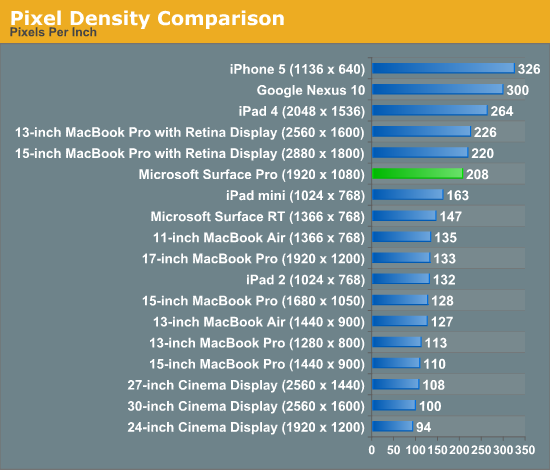
Once again Microsoft doesn’t do any substantial color calibration at the factory, but unlike on Surface RT you can run your own Windows display calibration software on Surface Pro to improve color accuracy if you have the right equipment.
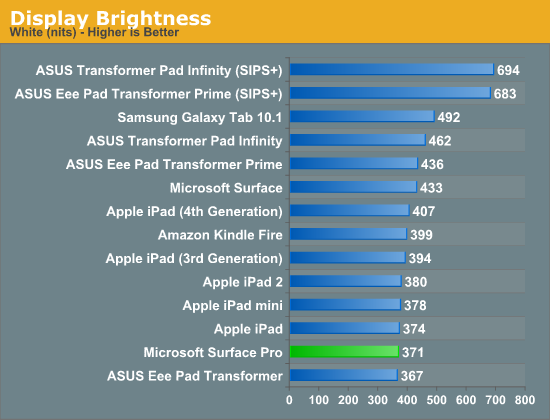
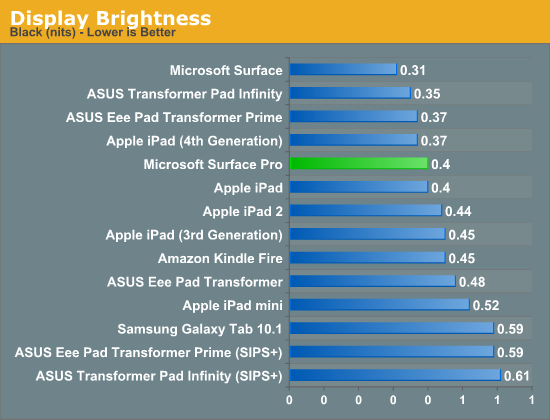
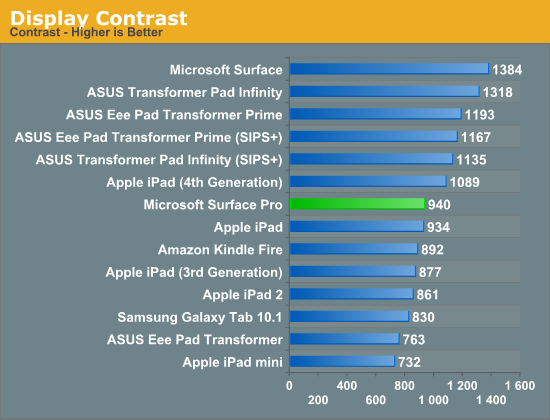
Out of the box my Surface Pro sample had an unusually high white point (~7500K), which negatively impacted its grayscale accuracy. To evaluate color accuracy I turned to our own Chris Heinonen's CalMAN smartphone/tablet workflow. Color accuracy is near identical to Surface RT, which is to say that it’s ok compared to PC notebooks from a couple of years ago but still far behind what you get out of the box from Apple.
Given that the majority of users don’t do any color calibration on their PCs, this becomes a real problem for consumer perception if your tablet doesn’t ship with accurate colors by default.
To see what the panel is capable of I ran it through our standard PC display calibration routine (which I can do since it’s running Windows 8 and is effectively a PC). I then re-ran it through our CalMAN smartphone/tablet workflow and ended up with much more pleasing results. While the display still lagged behind the iPad in one of the tests, it bested Apple’s Retina Display in the other two color accuracy benchmarks.
We'll start off by looking at the calibrated white point for these tablets. What you're looking for here is a number close to 6500K:
The next three charts look at accuracy represented as a difference between various source colors and what's reproduced on the display. The results are presented as average dE2000, with lower numbers being better.
First up is Grayscale performance, here we're looking at the accuracy of black, white and 19 shades of gray spread in between the two extremes:
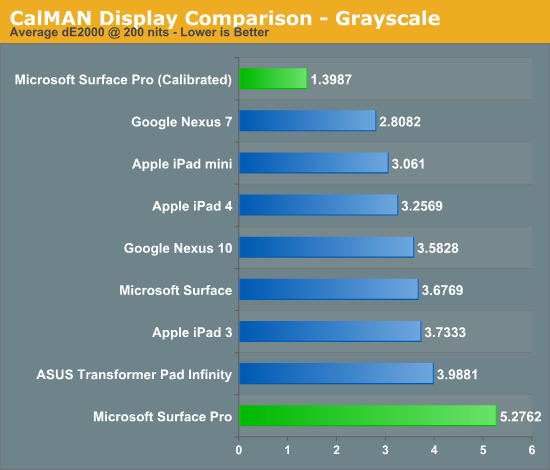
Out of the box grayscale performance is abysmal on Surface Pro. Calibrated accuracy, on the other hand, is just awesome.
First in our color accuracy tests is a saturation sweep. Here we're looking at 20%, 40%, 60%, 80% and 100% saturations of red, blue, green, magenta, yellow and cyan.
Our saturation sweep is the only test where even a calibrated Surface Pro can't match the iPad, it does do a lot better than Surface Pro without any color calibration however. Out of the box Surface Pro is considerably worse than any Apple tablet.
Gamut CIE Chart

Saturation CIE Chart
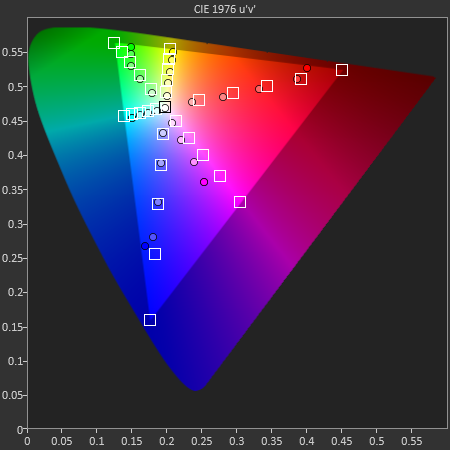
For our final accuracy test we're looking at the difference between a Gretag Macbeth colorchecker chart and the rendered swatches on these displays. Once again, lower numbers are better.
Out of the box Surface Pro and Surface RT are near identical here, and similar to the Nexus 10. With a good suite of calibration tools and supported hardware under Windows 8, Surface Pro has the potential to easily outperform the iPad if given the opportunity.
GMB Color Checker
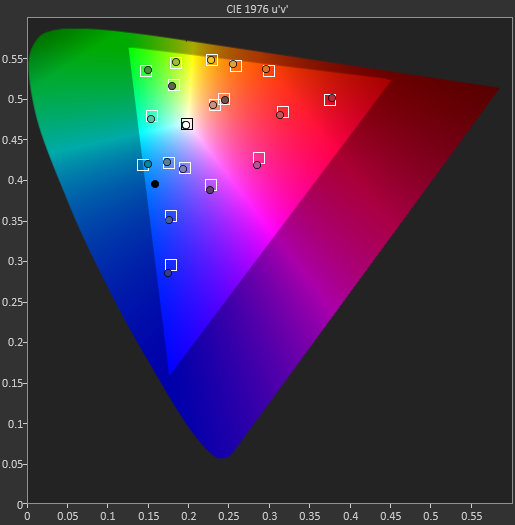
Surface Pro’s panel has real potential, it just needs a calibration pass - which is honestly something Microsoft should be doing these days, not the end user.
Mini DisplayPort but No Thunderbolt
Surface RT featured a single video output in the form of a micro HDMI port. Surface Pro adopts a mini DisplayPort output instead, and will have adapters to enable DVI and HDMI support.
The miniDP output immediately activates as soon as you plug a display into it. I sometimes had issues with display resolutions being set sub optimally, but generally speaking the process was as plug and play as you can get.
I did notice some visual tearing on the Surface Pro display when connected to an external HDMI monitor, similar to what I saw with Surface RT but not nearly as bad. I’m beginning to think something is a bit wonky with Windows 8’s multi-monitor support. What’s interesting is I didn’t see the issue on all displays, which is more than I can say for Surface RT. Update: It looks like this is hardware related. Even if the internal and external panels have the same refresh rate, Intel's HD 4000 won't guarantee that the refreshes will happen at the same time - which is why we see tearing. The tearing should only be present in clone mode, not extended desktop (I'll verify this shortly). It seems like Tegra 3 is worse in this regard, which is why the issue was so much more prevalent on Surface RT. I need to check other Ivy Bridge platforms and under OS X to see if the problem is as prevalent there as well.
The only disappointment here is Microsoft opted against integrating Thunderbolt into Surface Pro. I feel like Thunderbolt would’ve made a ton of sense in a device like Surface Pro, enabling one cable connection to both an external display and high-speed external storage. Given that Thunderbolt adoption remains fairly limited in the PC space I don’t think this is a huge loss for most of Microsoft’s target customer base, but I do feel like it’d be a good way of future proofing the device. The alternative that Surface Pro offers is the combination of miniDP and USB 3.0, which realistically speaking is probably good enough for most users. From a cost of integration standpoint vs. the number of users who would pay for it, it probably didn’t make sense for Microsoft to include Thunderbolt in Surface Pro, but that doesn’t change the fact that I wish it was there. It’d be nice for Apple not to be the only company really pushing Thunderbolt.
Camera Quality
Surface Pro, like Surface RT before it, features two integrated 720p cameras with no flash. Admittedly I didn't spend a ton of time taking photos with Surface Pro but imaging quality is just really bad compared to what you'll get out of an iPad 4. The results are borderline ok for use on the web but that's pretty much it, and forget about decent low light performance.


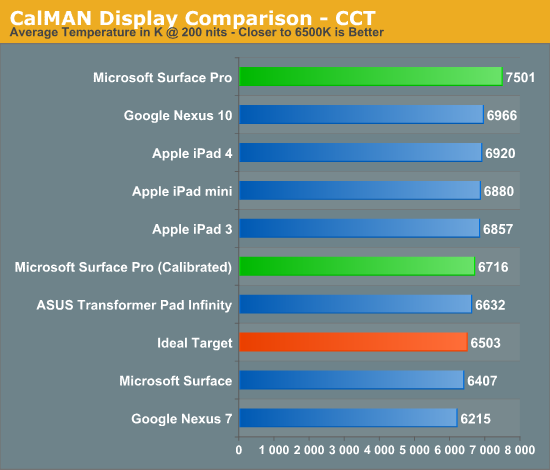
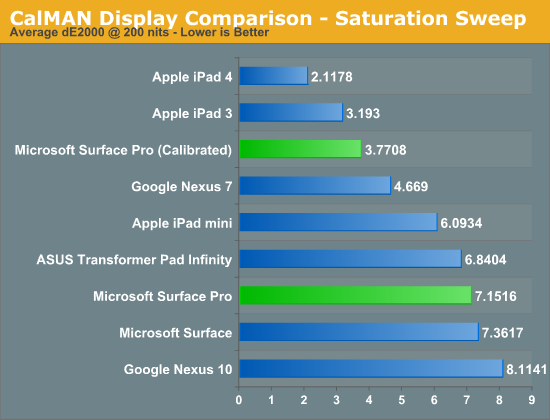
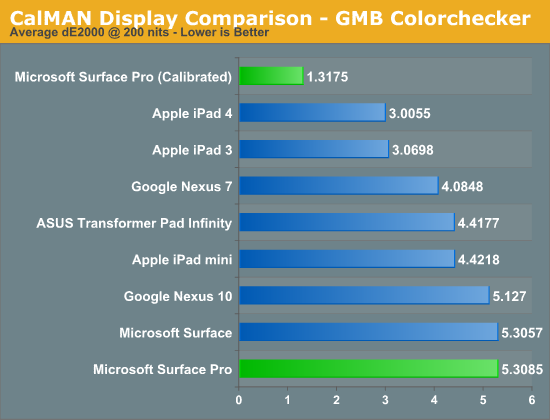










228 Comments
View All Comments
WCHS - Wednesday, February 6, 2013 - link
Sorry Anand, this is not the only solution. The best solution to this question is Ipad Mini + Ultrabook. I hate it when companies try to combine two good things and end up with one bad one. I don't even notice my Mini being in my ultrabook bag. I get both - I get long battery life, ultimate portability, full applications access when I need it, and can even use both at the same time - for the almost the same price as Surface Pro + keyboard.andrewaggb - Wednesday, February 6, 2013 - link
but you have the downside of your data being split between multiple devices... you download your mail twice, your music twice, whatever it is you work on twice... or you do entirely different things on both so there is no overlap.Or you read an email on your tablet because it's more convenient (this happens to me all the time), but you need to respond and you need to type a fair amount and sometimes include files or content that's on your laptop. So you end up switching devices. Maybe it's just me, but this happens to me a lot.
I'm not sure if surface pro is quite good enough yet, it's unclear to me whether it can drive two external monitors and I'd really rather have 256gb of internal storage. So maybe surface pro 2. I'd happily give up a separate laptop + tablet. Just like I happily gave up mp3 player + phone and often use my camera phone instead of my nice DSLR. Convenience will win in the end.
WCHS - Thursday, February 7, 2013 - link
No, that is the point - you mostly do "different things" on the two devices. Even for the common things - at least they are possible. A Surface Pro will never be an ereader. The other point is that the Ipad Mini has shown that the sweet spot for a handheld tablet is "smaller, especially lighter " than an Ipad 2,3,4 - not heavier. Thats it - the Surface Pro is not "handheld".andrewaggb - Thursday, February 7, 2013 - link
Could be right. I'm certainly not unhappy with the size or weight of my ipad, but it also rarely leaves my house.I could take a 7" tablet with me easily... but I recently bough a galaxy note 2, which is another hybrid device, and I personally quite like it.
I could see myself liking the surface pro for many of the same reasons I like the note 2. But it sounds like the current surface pro isn't quite there yet.
flyingpants1 - Wednesday, February 6, 2013 - link
I'd like to see a roundup comparing Win8 i5 convertibles, namely the Surface Pro, the Samsung Ativ 700T, the Dell XPS 12 (the one that has a crazy swinging flippy hinge), the Lenovo Yoga 13, the Asus ones, Taichi and the others.All of these devices have severe drawbacks.
The Surface pro is heavy and has no real keyboard or stand. The storage issue is a big joke. Probably the worst option of all.
The Yoga 13 is large, heavy and the keyboard is exposed.
The Dell XPS 12 is a slightly smaller Yoga and the keyboard isn't exposed on tablet mode.
The Ativ 700T is my favourite so far. Too bad it has a poor connection between the screen and dock..
I think each manufacturer should make a 10", 11", 13" of their tablets. IMHO 13.3" 1080p is more than enough to replace a 15.6".
faizoff - Wednesday, February 6, 2013 - link
"The Surface pro is heavy and has no real keyboard or stand. The storage issue is a big joke. Probably the worst option of all."Just curious what is the big joke about storage? It's plainly listed what you're going to get and like any other windows OS you can experiment on your own to maximize space.
Doominated - Wednesday, February 6, 2013 - link
Lol, if you think the Surface Pro has a "storage problem" you should try checking out some Yogapad setups. I've seen as little as 60 gigs partitioned to the C Drive out of the box.Sorry to break it to you, but the Surface Pro only has a storage space issue if you have absolutely no clue what you're doing with Windows. It takes all of 10 minutes to get yourself up to almost 100 GB of usable storage. Even more if you buy an mSDXC card.
Death666Angel - Wednesday, February 6, 2013 - link
I liked the review overall. And I hope you make a video review for this as well. :DThat said, I did notice some oddities.
First, I find it strange that you compare this so much to ARM based tablets. To me, there is a mountain between those 2 kinds of devices. The comparison to Ultrabooks is much more apt. :)
Secondly, the way you treat calibrated displays. You state:
"Given that the majority of users don’t do any color calibration on their PCs, this becomes a real problem for consumer perception if your tablet doesn’t ship with accurate colors by default."
All I have read on that issue is that our eyes are pretty good at adjusting to different color schemes. So unless you use one device that is calibrated exactly and one that is off, you will not notice a device being "wrong". So for most people, it is a non-issue. Then, you praise Apple for doing the calibration, which is fine because it is an extra service they provide (how much value it is to the standard customer is another matter). But what you don't say is that calibration is not eternal. At least everything I've read on the issue says that you have to calibrate displays every few weeks in order to ensure the continued accuracy of the results. Do tablet/laptop displays operate differently where they don't need recalibration down the road? Because if they do need recalibration, than that whole first calibration is looking much less desirable to me. If I need accurate colors, I have the necessary tools to get it myself. If I don't need it a simple calibration by eye is enough to give me a good result (compare the picture to my PC or TV monitor so that everything looks equal and is easy on the eyes).
Thirdly, your desire for TB. That is simply a personal taste thing and you make that very clear, so I have nothing to criticize. :D I just wanted to say that I do not look at a TB port when buying my PC stuff. The TB enabled things out there are not for me (too expensive, too useless), it adds cost and energy consumption to devices. So I'm pretty happy that MS isn't supporting it here. Unless it comes integrated in the PCH, I don't want it.
That's all I wanted to say. :)
Death666Angel - Wednesday, February 6, 2013 - link
Oh, one thing more: Please add metric units to the imperial ones. :)Death666Angel - Wednesday, February 6, 2013 - link
Damn, forgot something else: I'm really disappointed by the power adapter. I would like to see everything that is in a reasonable power envelope (sub 60W) to use a PSU attached to the plug (for the wall socket) and not half way between the plug for the wall socket and the device plug.